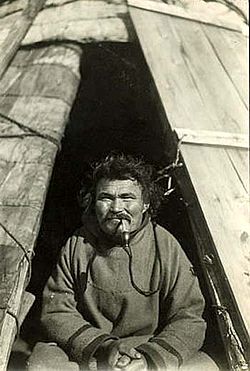Selkup people
The Selkup (Russian: селькупы) people are a native population of Russia. They come from northern West Siberia. They are a Samoyedic people. They used to be called Ostyak-Samoyeds (остяко-самоеды).[1] They live in the northern parts of Tomsk Oblast, Krasnoyarsk Krai and Tyumen Oblast (with Yamalo-Nenets Autonomous Okrug).[2]
 Flag | |
 Selkup man from Obdorsk, Ob river | |
| Regions with significant populations | |
|---|---|
| 3,649 | |
| Languages | |
| Selkup language | |
| Related ethnic groups | |
| Nganasans, Nenets, Enets | |
Language
Selkups speak the Selkup language. It is part of the Samoyedic languages, which is a group of Uralic languages.
History
The Selkups came from the middle basin of the Ob River. They came from the Yeniseian and Samoyedic peoples, who moved to that region from the Sayan Mountains.[3]
Contact with Russians and Tatars
The first time Selkups appeared in Russian records was in 1246.[1]
Turkic-Tatars ruled the Selkups and other Southern Samoyed people in the 13th century. Russians took over and ruled the Selkups by 1628. Some Selkups began to move to the Taz River and Turukhan River. They hunted, fished, and bred reindeer. They had a hard time breeding reindeer when Russian settlers started hunting them too. The Selkups tried to fight against the Russians, but they were defeated.[1]
In the 18th century, Selkups were given Russian names. They were also forced to convert to Christianity. They went through Russification, which means they were forced to give up their traditional culture and be more like Russians. In the 1930s, Selkup people were forced to settle, and their children were sent to boarding schools. Today, they suffer from racial discrimination, unemployment and alcohol abuse.[1]
Population
In 2002, 4,249 Selkups lived in Russia. In 2010, 3,649 Selkups lived in Russia.[4]
In 2001, 62 Selkups lived in Ukraine.
The main Selkup settlements in Siberia are Krasnoselkup and Kargasok.
Culture
Traditionally, the Selkups hunted, fished, and herded reindeer. They also used dugout canoes to sail on rivers.[5]
Kai Reinhold Donner (1888-1935) studied the Selkup people and their culture in 1911-1912 and 1914. Eugene Helimski also researched Selkup culture.
Selkup People Media
References
- ↑ 1.0 1.1 1.2 1.3 "The Red Book of the Peoples of the Russian Empire: Selkups". www.eki.ee.
- ↑ "ВПН-2010". www.gks.ru. Archived from the original on 2020-06-29. Retrieved 2022-03-14.
- ↑ Flegontov, Pavel; Changmai, Piya; Zidkova, Anastassiya; Logacheva, Maria D.; Altınışık, N. Ezgi; Flegontova, Olga; Gelfand, Mikhail S.; Gerasimov, Evgeny S.; Khrameeva, Ekaterina E.; Konovalova, Olga P.; Neretina, Tatiana (2016-02-11). "Genomic study of the Ket: a Paleo-Eskimo-related ethnic group with significant ancient North Eurasian ancestry". Scientific Reports. 6: 20768. doi:10.1038/srep20768. ISSN 2045-2322. PMC 4750364. PMID 26865217.
- ↑ "Russian Census 2010: Population by ethnicity". Archived from the original on 2013-12-04. Retrieved 2022-03-15.
- ↑ Forsyth, James (1994-09-08). A History of the Peoples of Siberia: Russia's North Asian Colony 1581-1990. Cambridge University Press. ISBN 978-0-521-47771-0.

